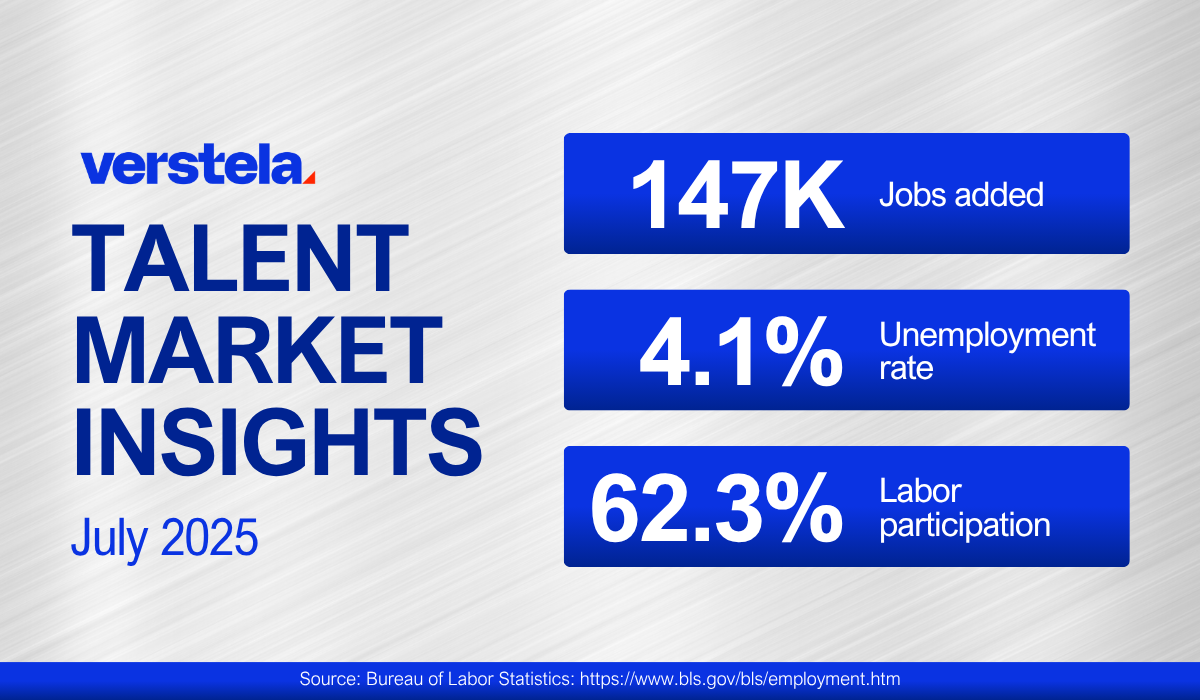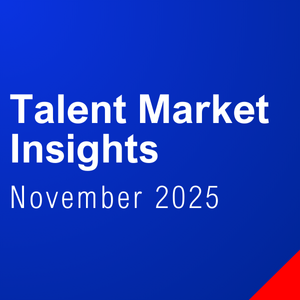
The latest jobs report shows continued growth—but signs of strain are beginning to emerge. As employers weigh rising costs, shifting policies, and participation trends, staying tuned into labor market shifts can help guide more effective workforce planning.
Here are the key takeaways from the June report: 147,000 jobs were added
- Unemployment dipped to 4.1%
- Labor force participation held at 62.3%
- Wages rose 0.2% month-over-month
These numbers reflect a labor market that’s still active—but softening in places. Most gains came from the public sector and healthcare, while private-sector hiring remained flat. Meanwhile, long-term unemployment rose, and more workers stepped away from active job search.
Below, we break down the trends and offer perspective on what it means for employers.
Job Growth at a Glance
June’s job growth was in line with the 12-month average. But the gains were concentrated in a few areas:
- State government added 47,000 jobs—40,000 of those in education
- Local education roles continued trending up (+23,000)
- Health care added 39,000 jobs, including hospitals (+16,000) and nursing facilities (+14,000)
- Social assistance continued to grow, up 19,000
In contrast, federal employment declined by 7,000, continuing a trend of cuts totaling 69,000 jobs since January.
Outside of these areas, employment was mostly flat across construction, manufacturing, retail, hospitality, transportation, and business services—suggesting many employers are holding steady or pulling back on hiring.
Unemployment & Participation
The unemployment rate ticked down to 4.1%, and the total number of unemployed people held at 7 million.
But several signs point to rising pressure in the labor market:
- Long-term unemployment rose by 190,000
- The number of discouraged workers—those who’ve stopped looking because they don’t believe jobs are available—increased by 256,000
- Labor force participation was flat at 62.3%, and the employment-to-population ratio stayed at 59.7%
These figures suggest more people are stepping away from the labor market—or facing increasing difficulty finding work.
Wage Trends & Hours Worked
- Wages grew 0.2% in June, bringing year-over-year wage growth to 3.7%
- The average workweek edged down to 34.2 hours, with similar shifts in production and nonsupervisory roles
Wage growth remains above inflation, but the pace has slowed—suggesting less pressure from demand and a potential easing in labor cost growth.
What Employers Should Watch
While the labor market remains stable on the surface, a few emerging patterns could shape how employers think about staffing in the months ahead:
- Job growth is steady, but concentrated. Most gains came from healthcare and government, while hiring in other industries has slowed—suggesting more uneven momentum.
- Fewer people are entering the workforce. Labor force participation hasn’t improved, and more jobseekers are stepping away from active search.
- Pressure may build on talent pipelines. Some economists point to immigration policy changes and participation shifts as early signs that talent availability could tighten.
These signals don’t require a shift in course—but they’re worth keeping in view as employers plan what’s next.
Winning Moves for Employers
The labor market remains active—but signs of slowdown and shifting participation mean now’s the time to take a closer look at your workforce strategy. Here are three moves to consider:
-
- Focus on roles that move the needle.
Hiring may be slower, but it hasn’t stopped. If you’ve been holding off, now’s a good time to revisit your priority roles—especially ones tied to revenue, retention, or compliance. Waiting too long could mean falling behind once demand shifts. - Don’t assume it’s easier to hire.
The market is cooling—but that doesn’t mean talent is easier to find. With participation flat and immigration-related shifts underway, availability could tighten in unexpected ways. Keep your outreach strong and your process efficient. - Use staffing to stay responsive.
Whether you’re managing headcount conservatively or covering short-term gaps, staffing gives you flexibility. It’s a smart way to stay productive without locking in long-term costs—and it keeps your workforce aligned with real-time demand.
- Focus on roles that move the needle.
Even in a steady market, small shifts can create ripple effects. Staying ahead doesn’t mean overreacting—it means planning with purpose.
Stay Prepared
Shifts in the labor market don’t always show up as big swings. Sometimes, it’s the slower pace or early indicators—like rising long-term unemployment or fewer people entering the workforce—that matter most.
At Verstela, we help employers read between the lines. Whether you’re weighing your next move or rethinking how to stay flexible, we’ll work with you to find smart, scalable solutions that match real-time demand.
Explore more insights, hiring tips, and market data in our Employer Resource Center.



